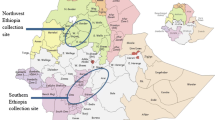Abstract
A total of 112 named cultivars and advanced breeding lines were assayed through horizontal starch electrophoresis to test the utility of isozyme loci as a means to objectively identify potato cultivars. Both leaf and tuber tissue were sampled in thirteen enzyme systems. Two buffer systems (Histidine-citrate, pH 5.7 and Lithium-borate, pH 8.3) were used to resolve 16 isozyme loci, of which 14 were scorable without progeny testing. A total of 43 scorable allozymes were detected. All cultivars or advanced breeding lines that were the result of hybridization were discriminated by their sum electrophoretic pattern, whereas, sports (i.e., Russet Burbank vs. Burbank) or line selections (i.e., Norgold Russet “M1” vs. “M2”) have patterns that are identical to the original mother clone. The allelic diversity within and among cultivars indicate that horizontal starch electrophoresis offers an objective means to discriminate sexually-derived potato cultivars.
Compendio
Se analizaron un total de 112 cultivares y selecciones avanzadas a través de electroforesis horizontal en almidón para probar la utilidad de loci de isoenzimas para la identificación objetiva de cultivares de papa. Se utilizaron dos sistemas buffer (Histidina-citrato, pH 5.7 y Litio-borato, pH 8.3) para separar 16 loci de isoenzimas, de los cuales 14 pudieron ser calificados sin pruebas de progenie. Un total de 43 aloenzimas pudieron ser caracterizadas. Todos los cultivares o selecciones avanzadas productos de hibridación fueron identificados por su patron electroforético aditivo, mientras que los productos de mutación (por ejemplo Russet Burbank vs Burbank), o líneas selectas (por ejemplo Norgold Russet “M1” vs “M2”) mostraron patrones idénticos al clon materno original. La diversidad alélica dentro y entre cultivares indica que la técnica de electroforesis horizontal en almidón es un método objectivo para distinguir cultivares de papa originados sexualmente.
Similar content being viewed by others
Literature Cited
Bailey, D.C. 1983. Isozymic variation and plant breeders’ rights.In: Isozymes in Plant Genetics and Breeding, Part A. Eds. S.D. Tanksley and T.J. Orton. Elsevier Science Publishers, Amerstdam 425–440.
Bassiri, A. and M.W. Adams. 1978. Evaluation of common bean cultivar relationships by means of isozyme electrophoretic patterns. Euphytica 27:707–720.
Bringhurst, R.S., S. Arulsekar, J.F. Hancock, Jr. and V. Voth. 1981. Electrophoretic characterization of strawberry cultivars. J Amer Soc Hort Sci 106(5):684–687.
Byrne, D.H. and T.G. Littleton. 1989. Characterization of isozyme variability in apricots. J Amer Soc Hort Sci 114(4):674–678.
Chase, R.W. 1989. North American Potato Inventory. Certification Section of the Potato Association of America.
Cousineau, J.C. and D.J. Donnelly. 1989. Identification of raspberry cultivars in vivo and in vitro using isoenzyme analysis. Hortscience 24(3):490–492.
Desborough, S.L. and S.J. Peloquin. 1968. Potato variety identification of electrophoretic patterns of tuber proteins and enzymes. Am Potato J 45:220–229.
Douches, D.S. and C.F. Quiros. 1987. Use of 4x-2x crosses to determine genecentromere map distances of isozyme loci inSolanum species. Genome 29:519–527.
Douches, D.S. and C.F. Quiros. 1988. Additional loci in tuber-bearing Solanums: Inheritance and linkage relationships. J Hered 79:377–384.
Douches, D.S., R. Freyre and K. Hicks. 1990. Use of RFLPs to fingerprint North American potato varieties.In: First Planning Conference for the Use of Molecular Techniques in Potato Germplasm Enhancement. CIP pp. 166–175.
Gebhardt, C., C. Blomendahl, U. Schachtschabel, T. Debener, F. Salamini and E. Ritter. 1989. Identification of 2n breeding lines and 4n varieties of potato (Solanum tuberosum ssp.tuberosum) with RFLP fingerprints. Theor Appl Genet 78:16–22.
Glendenning, D.R. 1983. Potato introductions and breeding up to the early twentieth century. New Phytol 94:479–505.
Loeschcke, V. and H. Stegemann. 1966. Proteine der Kartoffelknollen in Abhängigkeit von Sorte und Virosen (Polyacrylamide —Elektrophorese). Phytochemistry 5:985–991.
Martinez-Zapater, J.M. and J.L. Olivier. 1984. Genetic analysis of isozyme loci in tetraploid potatoes (Solanum tuberosum L.). Genetics 108:669–679.
May, B., J.E. Staub and L.J. Kuhns. 1982. Potato cultivars: genetic variation within putative clones. Am Potato J 59:179–184.
MacLeod, H.S. and W. Jones. 1937. A new variety from British Columbia. Am Potato J 14:93–99.
Mendoza, H.A. and F.L. Haynes. 1974. Genetic relationship among potato cultivars grown in the United States. Hortscience 9:328–330.
Olivier, J.L. and J.M. Martinez-Zapater. 1985. A genetic classification of potato cultivars based on allozyme patterns. Theor Appl Genet 69:305–311.
Quiros, C.F. and N. McHale. 1985. Genetic Analysis of isozyme variants in diploid and tetraploid potatoes. Genetics 111:131–145.
Rajora, O.P. 1989. Genetic structure and identification ofPopulus deltoides clones based on allozymes. Genome 32:440–448.
Salaman, R.N. 1926. Potato Varieties. Cambridge University Press, Cambridge, 378 p.
Staub, J.E., LJ. Kuhns, P. Grun and B. May. 1982. Stability of potato under different storage regimes. J Am Soc Hortic Sci 107:405–408.
Staub, J.E., L.J. Kuhns, P. Grun and B. May. 1984. Genetic basis for isozyme variation for alkaline phosphate and glucosephosphate isomerase inSolanum. Theor Appl Genet 67:505–513.
Stuber, C.W., J.F. Wendel, M.M. Goodman and J.S.C. Smith. 1988. Techniques and scoring procedures for starch gel electrophoresis from maize (Zea mays L.). Technical Bull. 286, North Carolina Agricultural Research Service, NCSU, Raleigh, North Carolina.
Tanksley, S.D. 1983. Molecular markers in plant breeding. Plant Mol Biol Rep. 1:3–8.
Zwartz, J.A. 1966. Potato varieties and their protein electropherogram characteristics. Eur Potato J 9:111–128.
Author information
Authors and Affiliations
Additional information
1 Journal Article No. 000122.
Rights and permissions
About this article
Cite this article
Douches, D.S., Ludlam, K. Electrophoretic characterization of North American potato cultivars. American Potato Journal 68, 767–780 (1991). https://doi.org/10.1007/BF02853807
Accepted:
Issue Date:
DOI: https://doi.org/10.1007/BF02853807




